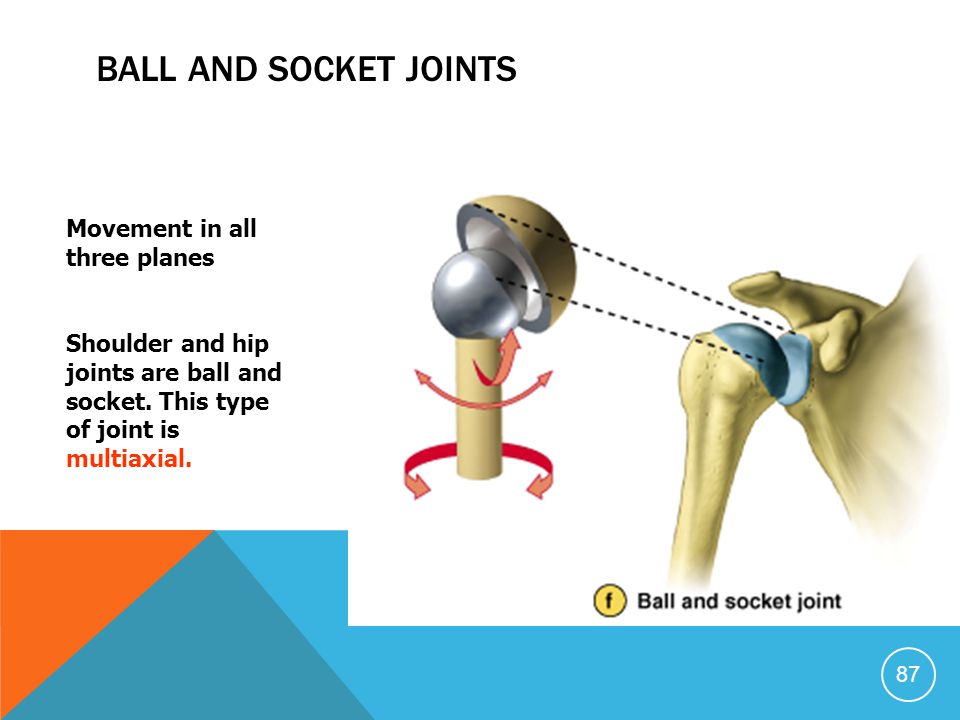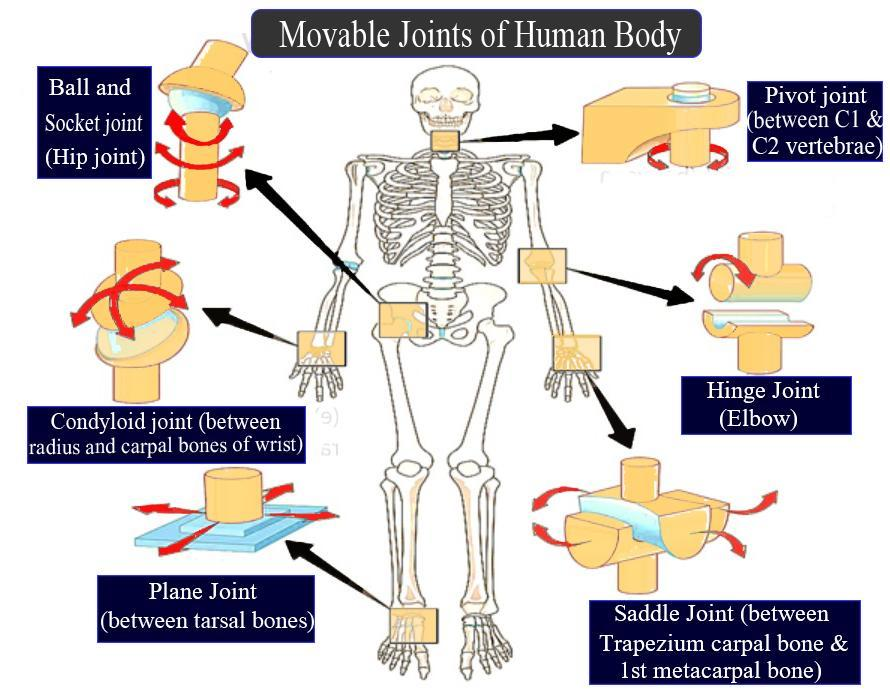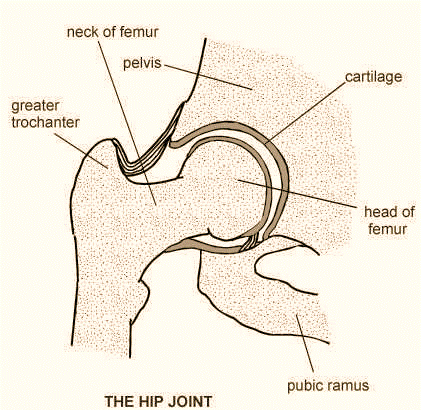Describe the Movement of a Ball and Socket Joint
There are six major types of synovial joints based on their shapes and the movements they permit ball-and-socket joints _____ joints plane joints _____ joints pivot joints and saddle joints. It is most highly developed in the large shoulder and hip joints of mammals including humans in which it.

What Is Joint Explain Ball And Socket Joint Along With Diagram
This organization allows the greatest range of motion as all movement types are possible in all directions.

. Ball and Socket Joints. Ball and socket joints are a type of synovial joint where the spheroid articular surface of one bone sits within a cup-like depression of another bone. Examples of ball-and-socket joints are the shoulder and hip joints.
Describe the location of synovial membranes. The ball and socket joint is a movable joint which allows backwards forward sideways and rotating movements. The ball and socket configuration allows for movement with 3 degrees of freedom which is more than any other type of synovial joint.
However ball-and-socket joints allow for large movements while the motions between bones at a plane joint are small. At the elbow the forearm would need to be flexed. Ball-and-socket joints possess a rounded ball-like end of one bone fitting into a cuplike socket of another bone.
Terms in this set 8 Describe a ball and socket joint. A ball and socket joint is a type of synovial joint that allows movement in almost every direction. These joints allow motion in numerous directions as the.
Ball-and-socket joints in which the rounded head of a bone fits into a large depression or socket are found at the shoulder and hip joints. The ball and socket joint is the type of joint with the most mobility. The distal bone is capable of motion around an indefinite number of axes with one common centre.
Thus they need more musculature around them to ensure stability. An example ball and socket joint are the shoulders. At the shoulder the arm would need to flex and medially rotate.
Ball and socket joints involve the round head of one bone the ball fitting snuggly into the rounded pocket of another bone the socket. The six types of synovial joints are given below classified bases on the movement exists. Briefly define the types of joint movements available at a ball-and-socket joint.
The multiaxial ball and socket joints allow for FLEXION EXTENSION ABDUCTIONADDUCTION and CIRCUMDUCTION. Ball-and-socket joints are classified functionally as multiaxial joints because they can move bones along several axes. Ball-and-socket joints possess a rounded ball-like end of one bone fitting into a cup-like socket of another bone.
These joints allow for a wider range of motion than any other type of joint. The articulating surface that is in the shape of a. Examples include ankle elbow knee joints.
A ball and socket joint is made up of a round end of one bone that fits into a small cup-like. In this one ball-shaped rounded bone fits into the cup-shaped depression of another bone. Discuss the joints involved and movements required for you to cross your arms together in front of your chest.
Schematic representation of a ball socket joint. The ball and socket joint is a type of synovial joint in which one bone is hooked into the hollow space of another bone. The depth of the cup and any additional fibrocartilaginous labrum.
The Role of Rheumatologists. Examples of ball-and-socket joints are the shoulder and hip joints Figure 7. Ball-and-socket joint also called spheroidal joint in vertebrate anatomy a joint in which the rounded surface of a bone moves within a depression on another bone allowing greater freedom of movement than any other kind of joint.
This organization allows the greatest range of motion as all movement types are possible in all directions. To cross your arms you need to use both your shoulder and elbow joints. This type of joint helps in rotatory movement.
Describe the structures that provide direct and indirect support for a synovial joint. It is a joint with a rounded bone referred to as a ball moving within a depression of. Shoulder and hip joints are examples of Ball and socket joints.
Describe the ball socket pivot hinge and gliding joints and provide an example of each. Ball and socket joints also allow types of movement called abduction adduction rotation and. Range of motion of ball socket joints.
These joints allow for movement in three different planes. The distal bone is capable of motion around an indefinite number of axes which have one common centre. This joint allows flexion-extension adduction-abduction and rotation movement.
Ball-and-socket joints have the greatest range of motion of all synovial joints. Examples include hip and shoulder joint. Both plane and ball-and-sockets joints are classified functionally as multiaxial joints.
Spheroidal joint or a ball-and-socket joint. The possible movements include flexionextension abductionadduction. See all related content.
The shoulder joint is a ball-and-socket joint. The bones of this joint are egg shaped or slightly globular shaped they articulate with the cup-shaped cavity of the articulating bone. A ball and socket joint comprises bone forming a round head or cup-like or socket-like structurewhereas the other forms a ball-like structure which fits in the cup.
The ball and socket joint is a type of synovial joint. This joint allows a wide range of motion than the other types of joints. It is a kind of joint where the ball-shaped articulating surface of one rounded bone fits into the cup-like depression of another bone.
The muscles that surround the joints permit the humerus and femur to move away from the bodys midline abduction toward the bodys midline adduction forward flexion and backwards extension. It allows only flexion. Ball-and-socket joints are multiaxial joints that allow for flexion and extension abduction and adduction circumduction and medial and lateral rotation.
The hinge joint is another type of synovial joint.

Ball Socket Joint Definition Examples Video Lesson Transcript Study Com

What Is A Ball And Socket Joint Class 11 Biology Cbse

Why Is The Ball And Socket Joint The Most Movable Quora

What Is Ball And Socket Joint And Hinge Joint Tutorix

Ball And Socket Joint Anatomy Britannica

4 Answer The Following A What Is A Ball And Socket Joint Brainly In

Lab 10 Joints And Body Movements Flashcards Quizlet

Long Answer Question Explain The Structure Of The Ball And Socket Joint Give Two Examples Of Such Joints In The Human Body What Kind Of Movement Does Such A Joint Allow Snapsolve

Ball And Socket Joint Is Present In A Wrist B Fingers Class 12 Biology Cbse

Ball Socket Joint Movement Examples Function What Is A Ball Socket Joint In The Body Video Lesson Transcript Study Com

Ball And Socket Joint Radiology Reference Article Radiopaedia Org

Unit 1 Types Of Joints Ppt Video Online Download

Joints And Skeletal Movement Biology For Majors Ii

Describe Ball And Socket Joint And Hinge Joint Class 11 Biology Cbse

Biology Simailarity And Difference Between Hinge Joint S And Ball And Socket T

Is A Ball And Socket Joint A Uniaxial Joint Because Motion Is Limited To Rotation In A Single Plane Socratic

Comments
Post a Comment